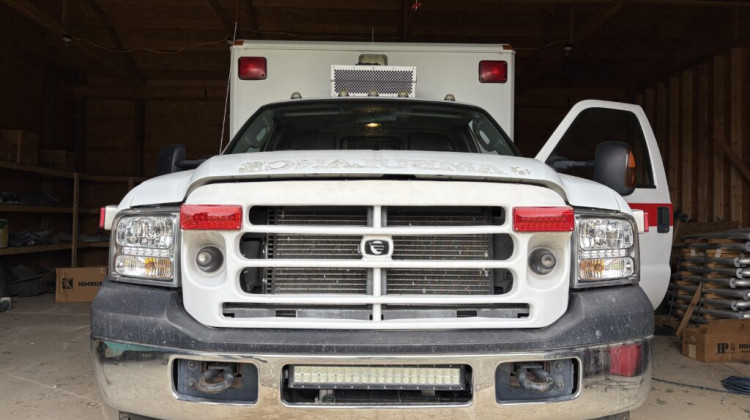
Storm Lake is home to a population where more than a third identify as Latino or Hispanic and nearly one in five identify as Asian.
Natalie Krebs/Side EffectsEmilia Marroquin has experienced firsthand just how much Storm Lake, Iowa, has changed over the past two decades.
On a driving tour of the town, she points to a building out the window of her car.
“The only Mexican restaurant that was in town was on this corner, [and] there were White people running the restaurant,” she said.
Marroquin, a native of El Salvador, moved from California to Storm Lake with her family in the 1990s to escape rising crime rates. They were tipped off about the small western Iowa town by a friend’s mother.
Marroquin said at first, the family lived in a hotel as they struggled to find housing. She didn’t know anyone who spoke Spanish, so she learned to order by number at the nearby Burger King.
Marroquin and her husband had secured jobs at the Tyson Foods plant before leaving California. But she only lasted a few days in the harsh work environment.
“I remember the second day I was crying, saying ‘I’m not coming back to this place. I don’t like it. I hate it,’” she said.

But the family stayed in Storm Lake. Marroquin left Tyson, started a new job, learned English, earned high school and college degrees, and got involved in many aspects of community life.
She’s now one of many immigrants who proudly call Storm Lake home.
Like many meatpacking towns in the Midwest, Storm Lake is much more diverse than the areas that surround it. Here, more than 1 in 3 residents identify as Hispanic or Latino. Nearly 1 in 5 are Asian.
Nationwide, COVID-19 disproportionately affected communities of color, in part because the U.S. relies on immigrant workers in food and agriculture; they never stopped working even as other businesses shuttered.
One research study found the presence of a meat processing facility increased a county’s per capita transmission rates by up to 160 percent. Many of these communities, like Storm Lake, are still reeling from the pandemic.
A diverse community
In a state like Iowa, where 85 percent of the population identifies as only White, Storm Lake stands out with less than 40 percent of the population identifying as White and not Hispanic.
Buena Vista County, where Storm Lake is located, is considered the most diverse county in the state, according census data.
The town’s official population is 11,269. But most town officials agree it’s likely higher, due to the high number of transient workers and lower than average census participation.

“It is probably the most unique community in the state of Iowa,” said Mike Porsch, the mayor of Storm Lake.
Storm Lake’s demographics have shifted dramatically in the past 30 years. According to the 1990 census, 95 percent of the town identified as White. Just 3.5 percent identified as Asian, and 1 percent identified as Hispanic.
Porsch remembers his graduating class in the 1970s being almost exclusively White. He’s welcomed the change.
“It's so beneficial to the kids that graduate from here because they know what the real world is like,” Porsch said. “I mean it isn’t an all White real world out there.”
The driving force behind the diversification of Storm Lake is the town’s pork and turkey meatpacking plants. They’re currently owned by Tyson Foods, but have existed in the community under different ownerships for decades.
The plants have attracted thousands of immigrant workers over the past 20 years and are the economic engine of the town, employing around 3,000 workers.
Immigrant families are vital to smaller, rural communities, like Storm Lake, which have seen their populations shrink in recent years.
“They provide the workforce for our restaurants or cashiers … they’re receptionists at the clinics,” Porsch said. “I mean, they've filled the job void throughout the community.”
The Tyson plants’ impact is obvious driving through Storm Lake. The facilities can be seen throughout town, poking out behind preschools and cemeteries.
Large steel trucks full of pigs regularly pass through the main roads, just blocks from the shores of Storm Lake where Tyson sponsors things like lakeside snack stands.
Tyson advertisements emphasizing generous sign-on bonuses and starting wages appear everywhere throughout the town.
The strain of an outbreak
When Tyson’s pork plant experienced a COVID-19 outbreak in spring of 2020, it sent large ripples through the community.
On May 28, 2020, Tyson announced it was shutting down its pork processing facility for several days after state health officials confirmed the outbreak.
The company issued out a press release several days later stating internal testing found 591 of its 2,303 employees at the pork plant tested positive for the virus — or one-quarter of all employees — with 75 percent of those infected not showing any symptoms.
Porsch said, at the time, finding the balance between protecting workers and keeping the food supply and the economy going was challenging for Tyson and the community.

“[It’s] kind of a Catch-22,” he said. “You'd really love to have time off work to try to get it under control and then bring workers back. But then the other part is, then you're not providing food for the country.”
Research has shown the spread of COVID-19 was significantly greater in meatpacking communities across the country.
According to a study in Food Policy, counties with large pork processing facilities saw a bump in per capita COVID transmission: Counties with large beef processing plants saw per capita transmission rates increase by 110 percent, while those with chicken processing facilities transmission rates increased 20 percent.
Deacon Hector Mora worked in the Tyson turkey processing plant for more than a decade before he left to work for St. Mary’s Catholic Church in May 2020 — the same month as the outbreak at the pork plant.
Mora, who’s originally from Mexico, moved to Storm Lake from another town in Iowa after his wife took a job in a Tyson plant. When he quit, he had been a supervisor for three years.
He said he felt Tyson took precautions to protect workers, but said many workers confided in him at the time that they were really scared.
“I used to tell them, ‘Just calm down. I know we have a bad situation. But don't let these fears be controlling you all the time,’” he said.

The outbreak hit the town’s Microneasian and Latino communities particularly hard, said Father Brent Lingle, who’s been the pastor at the church for two years.
“I would look back at the burials that I did of COVID-related deaths, and a majority of those were from our Micronesian community,” he said. “Second would be in our Hispanic community.”
The outbreak strained Storm Lake’s health care infrastructure.
At the United Community Health Center, Dr. Natalie Schaller said the federally qualified health clinic, which services many uninsured patients and underserved communities, had to make a makeshift COVID clinic out of a conference room.
“It was just out of this world,” she said. “It was unlike anything that I've ever experienced outside of, like, traveling and working in underserved third world countries.”
Schaller has worked at the clinic for about eight years. Her patients come from a wide variety of cultures. Many are meatpacking workers and their families.
One way she said she’s learned to bridge cultural gaps and build trust with her immigrant patients is to embed herself in their communities and create long lasting relationships with entire families.
“I might coach some of their children in soccer,” she said. “And we're there on the weekends together, building a bond and getting to know each other better.”
Schaller said the time period around the outbreak was physically and emotionally draining.
“You know, honestly, just a part of being in this community is knowing and loving some of the people who struggled the most, and ultimately passed away,” she said, tears welling in her eyes.
The fallout continues

Many Storm Lake residents say the fallout from the spread of the virus is ongoing.
Storm Lake School District Superintendent Stacey Cole said the pandemic has been particularly hard on children.
The district is one of the most diverse in the state: About 87 percent of students are people of color, most are immigrants and 57 percent are English language learners.
Cole said she’s only beginning to see the long-term impact of the pandemic on students and that many are showing signs of extended trauma.
“We know our kids are reporting anxiety, depression — all of those types of things that you see when people are struggling with their mental health,” she said. “We are seeing that at a very increased rate.”
Cole said the district has invested more into mental health resources, such as virtual therapy options, this year.
Meanwhile, public health officials said the pandemic has highlighted the need for more funding and support for local departments that serve diverse populations, like Buena Vista County.
“I'm not gonna say we're special, but we are special. We have a very diverse community when you look at the rest of the state, and it does take more time and more dollars,” said Julie Sather, who heads the Buena Vista County Health Department.
Sather said the 13-person department could use more resources, including interpreters, instead of relying on outside language lines, a dial in service to get interpreters.
But many in Storm Lake say the community ultimately is full of incredibly resilient people.
“I look at immigrants and refugees, and I see resilience and stamina and strength,” said Di Daniels, one of the founding members of SALUD, a community health organization. “I wonder sometimes this is just one more thing, one more hurdle they have to get over.”
Marroquin, who’s also a member of SALUD, agreed that many immigrants like herself have learned resilience through overcoming challenges, like starting life in a new country.
“If you have been going through the worst things, adapting to COVID will be something that you find a way,” she said.
This story comes from a reporting collaboration that includes Iowa Public Radio and Side Effects Public Media — a public health news initiative based at WFYI. This project was funded by USC’s Center for Health Journalism. Follow Natalie on Twitter: @natalie_krebs.
9(MDAyMzk1MzA4MDE2MjY3OTY1MjM5ZDJjYQ000))
 DONATE
DONATE






 Support WFYI. We can't do it without you.
Support WFYI. We can't do it without you.